Sushi is a landmark food in Japan and Japanese culture. For centuries, the people of Japan have eaten raw fish in various forms. Today, sushi is a popular Japanese dish around the world!
In this article, we will look at some different types of sushi – and how to say them in Japanese!
5 Types of Sushi
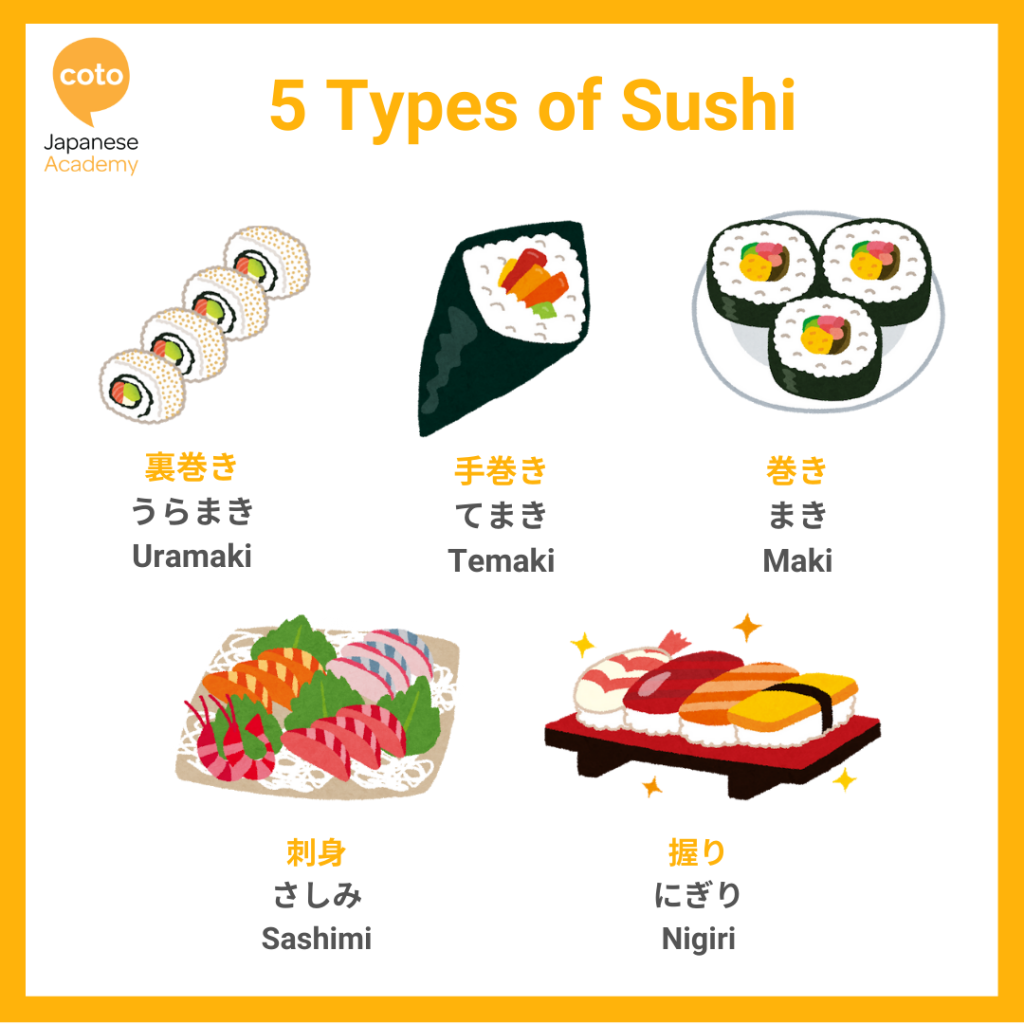
1) Uramaki Sushi 裏巻き寿司/うらまきずし
Although Uramaki sushi (uramakizushi) is very popular in the west – It is actually not very common in Japan.
The word Uramaki is 裏 → back and 巻き → roll. This is because the rice is on the outside and the seaweed on the inside. Popular Uramaki zushi rolls in the west are California rolls, dragon rolls, and others like them!
2) Temaki Sushi 手巻き寿司/てまきずし
Temaki sushi 手巻き寿司 (temakisuzhi) means “hand rolled sushi”. It is a popular house-party food, due to it being easy to serve.
As the name implies, Temaki sushi is rolled up by hand. The seaweed is on the outside, and people can often customize what they want to put inside it. Next time you need to prepare dinner for a lot of people – consider serving Temaki sushi!
3) Maki Sushi 巻き寿司/まきずし
Similar to Temaki sushi, Maki sushi (makizushi) is rolled with the seaweed on the outside, with rice inside and fish in the middle. Maki sushi is far more popular at sushi restaurants in Japan than uramaki sushi – and Maki sushi rolls are often eaten last due to their rich flavor.
4) Sashimi 刺身/さしみ
Sashimi is not quite sushi – it is raw fish (or meat), thinly sliced and often served on ice with soy sauce and wasabi.
However it is often served at Japanese sushi restaurants – as well as Japanese Izakaya! For this reason, we have included it in our list!
5) Nigiri 握り寿司/にぎりすし
This is the most popular form of Japanese sushi in Japan. Often prepared by hand, and served as 2 pieces. Nigiri sushi is raw or cooked fish on top of a small ball of rice, sometimes with some wasabi inside.
Maguro Sushi – Tuna

鮪 (Maguro – tuna) has different options for flavor and texture depending on the part of the fish that it comes from.
Toro is the fatty part from the belly of the fish. Akami (赤身) is the lean part from upper back. It is the most frequently-used part of the fish for sushi.
本まぐろ – honmaguro – is Pacific bluefin tuna.
Sāmon Sushi – Salmon

The サーモン (sāmon – salmon) used for making sashimi and sushi in Japan is Atlantic Salmon. Japanese sake/shake (鮭) means Chum salmon (シロザケ), and should not be eaten raw!
Ikura (いくら) is Salmon roe (eggs), and is quite expensive! It is often served on top of rice and inside seaweed with a cucumber – just like the picture above!
Ika and Tako Sushi – Squid and Octopus

Ika (烏賊/イカ – squid) and Tako (蛸/タコ – octopus) are both considered “light” flavored fish. And yes, these are almost always served raw!
Ebi Sushi – Shrimp
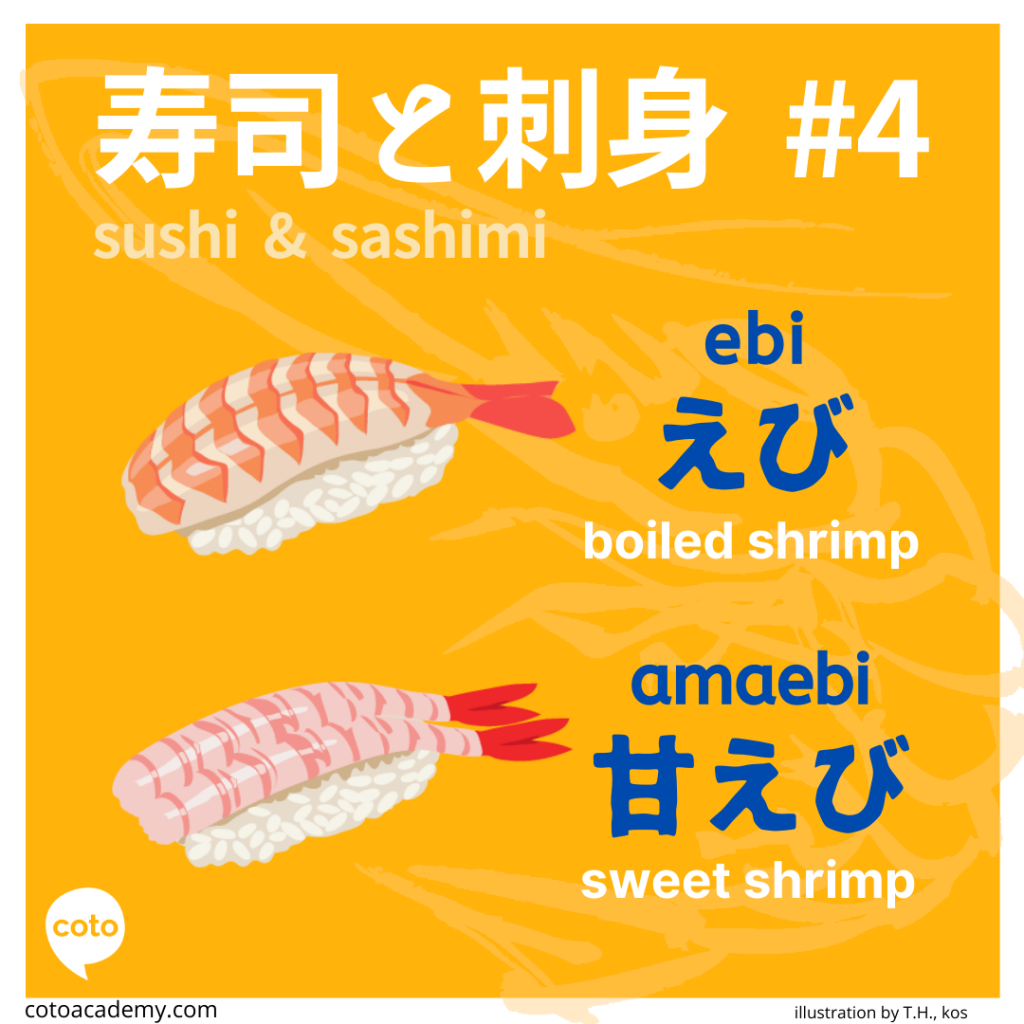
Did you know that Japanese sushi serves multiple types of shrimp (海老/えび)???
Here are some of them!
- 海老 – ebi – shrimp
- 甘えび – amaebi – sweet shrimp (commonly served raw)
- ぼたん海老 – botan’ebi – Jumbo shrimp (plumper and larger than amaebi with similar taste.)
- 車海老 – kurumaebi – Japanese tiger prawn (commonly used for Edomae-style sushi)
Maki – Rolls
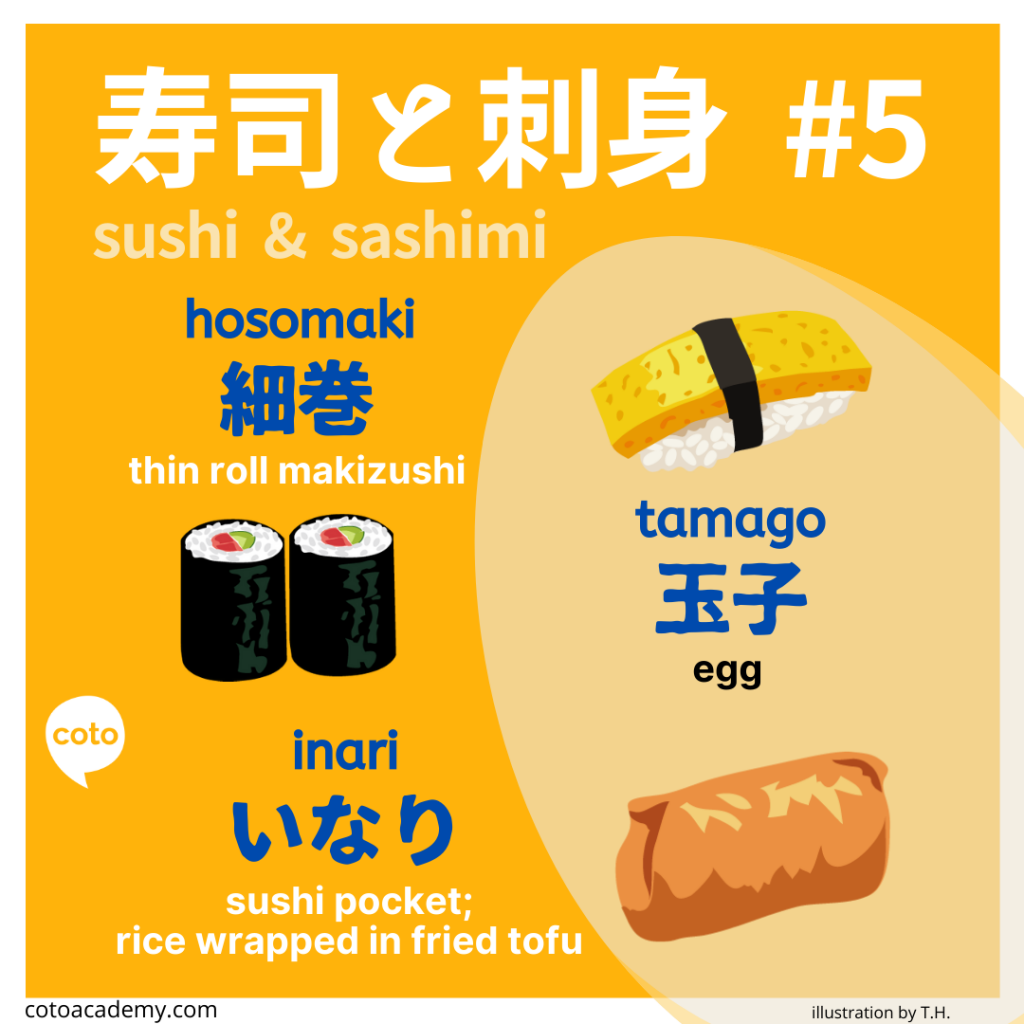
細巻/細巻き Hosomaki diameter is around 3cm, and there is usually only one ingredient inside. It’s thin and rolled with nori and looks like a gun, which is why it’s also sometimes called 鉄砲巻き (teppō-maki).
Some common hosomaki are:
- かんぴょう巻き – kanpyō maki – dried gourd roll.
- かっぱ巻き – kappa maki – cucumber roll.
- 納豆巻 – nattō-maki – fermented soybean roll.
- 鉄火巻 – tekka maki – sliced raw tuna roll.
There is also 太巻 – futomaki – which is a thick roll of makizushi. With a diameter above 5cm, it can hold more than one kind of ingredient.
The 玉子 (tamago – egg) sushi is often wrapped with some seaweed to hold it together. This is a sweeter piece of sushi – almost like a dessert!
Kai/Gai – Shellfish
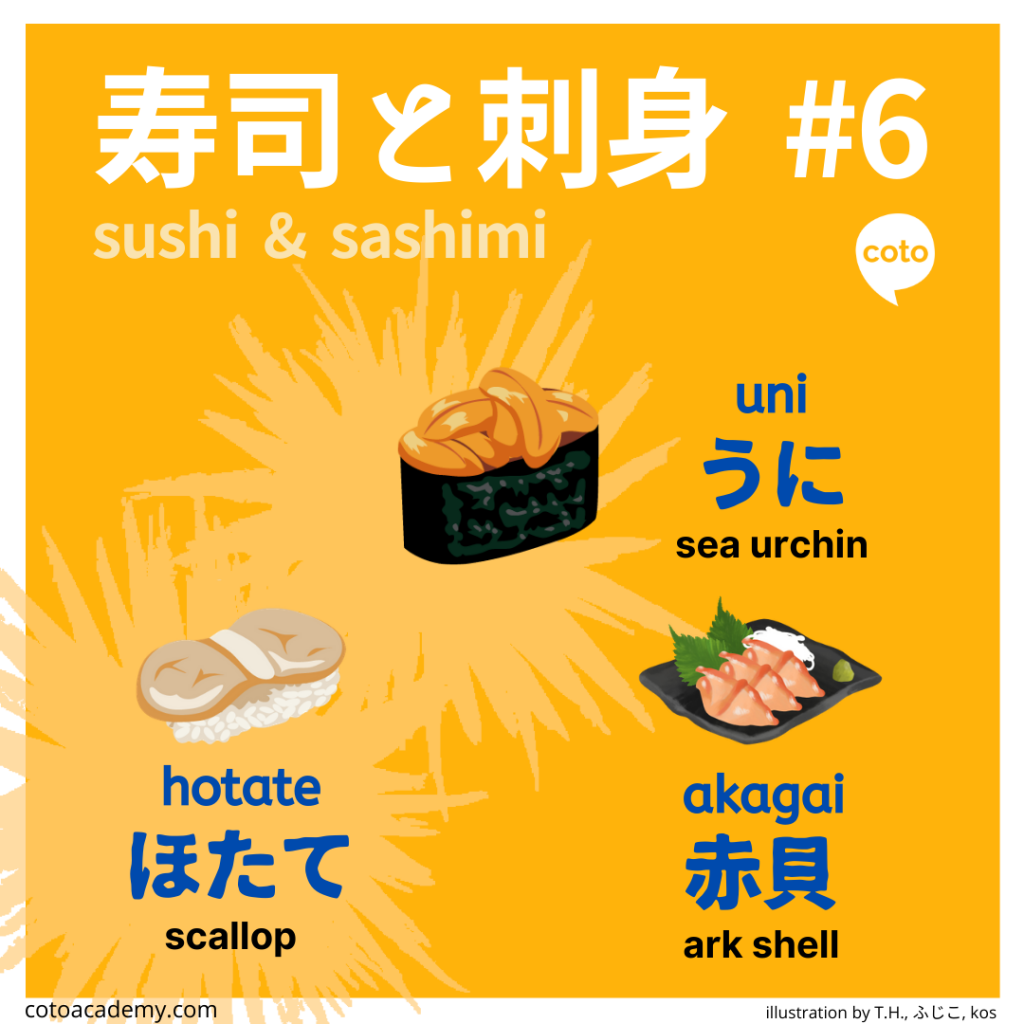
Shellfish (Kai/Gai – 貝) are also popular picks for sushi – especially the popular うに!
Here are some different kinds of shellfish in Japanese:
- 帆立 – ほたて- hotate – scallop.
- 赤貝 – あかがい – akagai – red clam, ark shell.
- ホッキ貝/北寄貝 – ほっきがい – hokkikai – Sakhalin surf clam.
- つぶ貝 -つぶがい – tsubugai – whelk.
- 海栗/海胆 – うに – uni – sea urchin.
Sakana – Fish
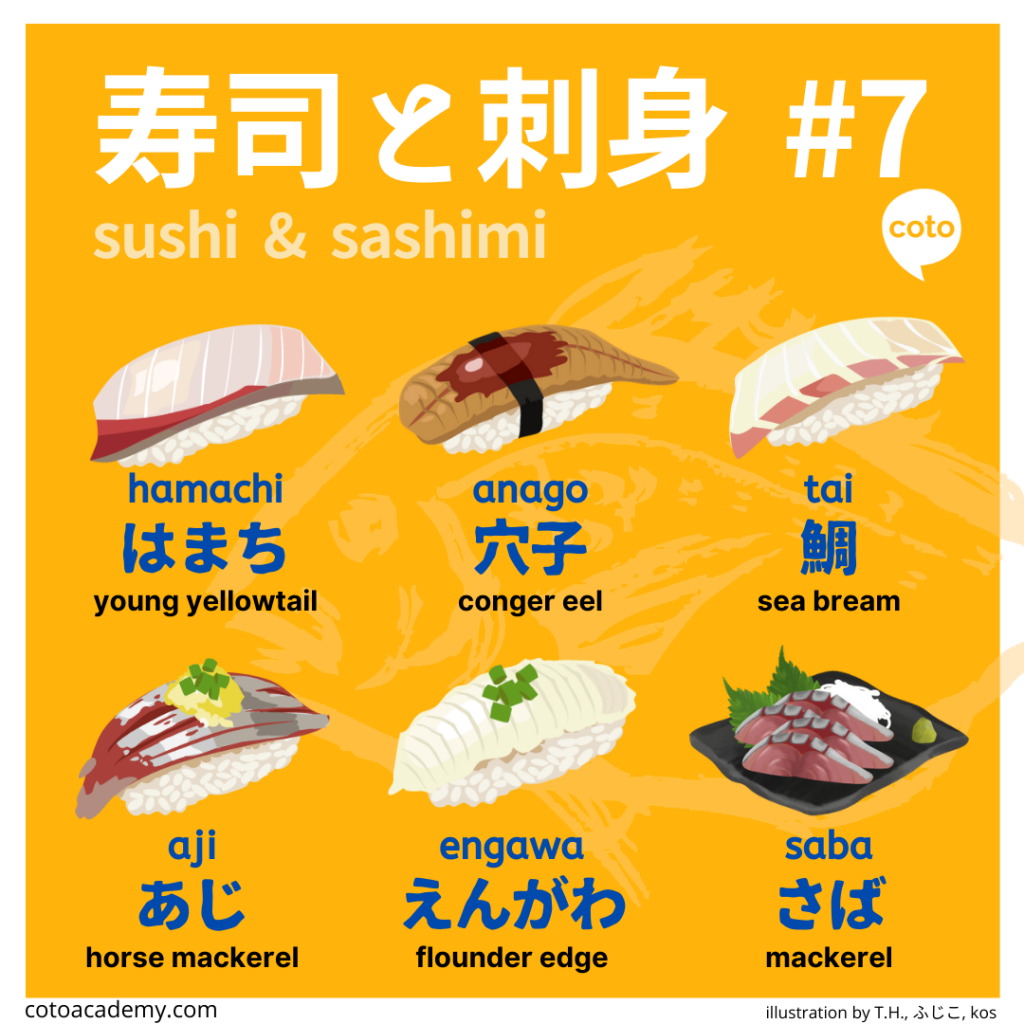
Here are some more types of sushi fish!
- 魬 – はまち – hamachi – young yellowtail.
- 鰤 – ぶり – buri – yellowtail.
- 穴子 – あなご – anago – conger eel.
- 鯛 – たい – tai – sea bream.
- 鯵 – あじ – aji – horse mackerel.
- えんがわ – engawa – flounder edge, fluke fin.
- 鯖 – さば – saba – mackerel.
The えんがわ fish gets its name from the word for a veranda in a Japanese house that resembles a porch (縁側 – engawa). It is the meat at the base of a fin from ヒラメ(hirame – flounder ) and カレイ (karei – righteye flounder.) It is a very precious part, and only 4 pieces can be taken from a single flounder.
Ordering Sushi at a Restaurant in Japan
Sushi restaurants in Japan usually fall into one of 2 categories: Conveyor belt sushi (回転寿司) and over the counter sushi restaurants.
Conveyor belt sushi is fun and family friendly, but the quality is often lower than the over the counter sushi. It is more affordable and more convenient, however, making it an excellent option for a casual dinner out! These establishments often have touchscreen menus available, so you can order as you go until you are full!
The over the counter sushi is an experience of it’s own. You can watch them make the sushi right in front of you before they pass it over the counter!
These restaurants often offer sets – or “courses” – that are prepared by the sushi chef for your dining pleasure. You should eat the sushi as soon as you receive it for the best taste!
You can also order with “omakase!” (おまかせ) – which means “I’ll leave it to you!”
Sushi can be eaten with either chopsticks (おはしーohashi) or bare hands. Either one is acceptable!
Hopefully this article was able to provide you with useful information about sushi in Japan and Japanese sushi names! Maybe now you can try out ordering some new kinds of fish in Japanese next time you are at a sushi restaurant 🙂